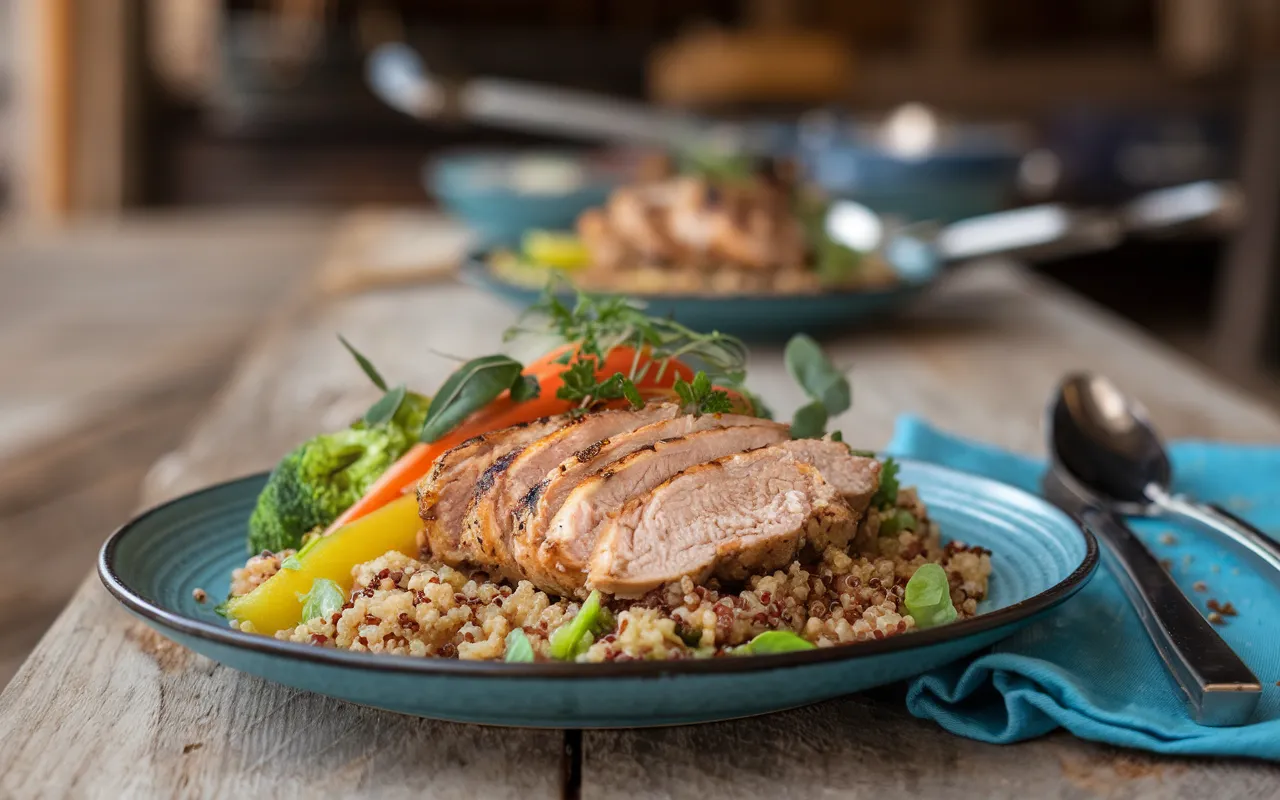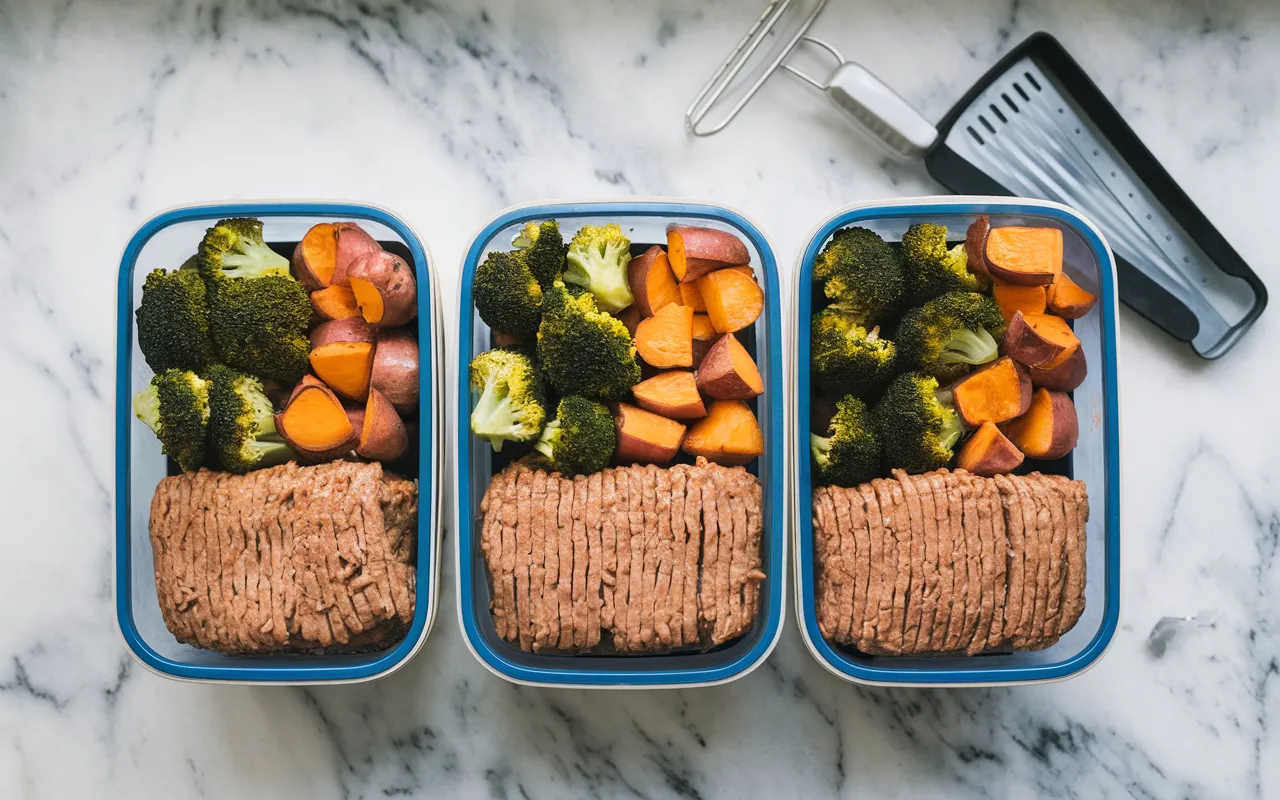Ground chicken has become a go-to option for many health-conscious individuals. Whether you’re striving to lose weight or seeking a versatile protein source, lean ground chicken often comes highly recommended. But what makes it such a favorite for those on a weight-loss journey? This article explores the nutritional profile, health benefits, and smart ways to include ground chicken in your diet. Along the way, we’ll compare it with other proteins, address common concerns, and provide practical tips for your kitchen. Let’s uncover the truth about ground chicken’s role in weight loss.
Understanding Ground Chicken and Its Role in Weight Loss
What is Ground Chicken?
Ground chicken is precisely what it sounds like: chicken that has been finely chopped or ground into a uniform consistency. It typically consists of a mix of dark and light chicken meat, with some varieties including skin for additional fat content. However, more health-conscious options like lean ground chicken have become widely available, offering a low-fat alternative.
Why Choose Ground Chicken for Weight Loss?
When it comes to weight loss, calorie control and nutrient density are crucial. Ground chicken ticks both boxes. It’s a high-protein, low-calorie option that helps maintain muscle mass while promoting satiety. In fact, lean proteins like chicken can curb appetite and keep you fuller for longer—making it easier to resist temptations.
Moreover, ground chicken is a versatile ingredient. From healthy tacos to protein-packed soups, it can fit seamlessly into various meal plans. According to Healthline, choosing lean cuts of meat is vital for balancing nutrients without overloading on fats.
How Does Ground Chicken Support a Weight Loss Plan?
The science is simple: creating a calorie deficit while maintaining sufficient protein intake is essential for weight loss. Ground chicken is relatively low in calories, especially when compared to fattier meats like beef or lamb. Pairing it with high-fiber vegetables or whole grains can result in a nutrient-packed meal that aligns with your goals.
Incorporating lean protein sources like ground chicken not only aids in weight loss but also provides essential vitamins and minerals, such as iron and zinc, which support overall health. Ready to discover the deeper nutritional breakdown? Stay tuned as we delve into the facts in the next section.
Nutritional Profile of Ground Chicken
Macronutrient Composition
Protein Content and Its Benefits for Weight Loss
One of the standout features of ground chicken is its high protein content. Protein serves as a cornerstone in weight loss diets, aiding in muscle preservation and increasing metabolism. A 100-gram serving of lean ground chicken offers approximately 20-25 grams of protein, making it a powerhouse for those striving to shed extra pounds. This nutrient promotes satiety, reducing overall calorie consumption and keeping hunger pangs at bay—a win-win for your weight-loss journey.
Fat Content: Differentiating Between Lean and Regular Ground Chicken
Ground chicken can vary significantly in fat content depending on its preparation. Regular ground chicken might include skin and dark meat, increasing its fat levels. On the other hand, lean ground chicken—made solely from chicken breast—contains far fewer calories and fats. For instance, while regular ground chicken has about 10-15 grams of fat per 100 grams, lean chicken boasts less than 5 grams. Opting for lean varieties not only supports your weight-loss goals but also contributes to a healthier cardiovascular system.
Carbohydrate Levels in Ground Chicken
Ground chicken is naturally carbohydrate-free, making it a fantastic choice for low-carb or ketogenic diets. This quality makes it a versatile ingredient that can be paired with carb-rich vegetables, whole grains, or legumes without adding extra carbs from the protein itself.
Micronutrient Content
Vitamins Present in Ground Chicken
Ground chicken contains essential vitamins, notably the B-vitamin family, which supports energy metabolism. Specifically, vitamin B6 plays a vital role in breaking down proteins, fats, and carbohydrates, while niacin (vitamin B3) contributes to healthy skin and proper digestive function. These benefits make ground chicken not only a lean protein option but also a nutrient-packed choice.
Minerals Found in Ground Chicken
When it comes to minerals, ground chicken is a reliable source of iron and zinc. Iron aids in oxygen transport and energy production, which are crucial for maintaining an active lifestyle and boosting exercise performance. Zinc, on the other hand, supports immune health and promotes wound healing. By integrating ground chicken into your meals, you can meet your daily requirements for these essential nutrients without adding unnecessary calories.
Health Benefits of Ground Chicken
High-Quality Protein Source
Role of Protein in Muscle Maintenance and Metabolism
Protein does more than just fill you up; it actively works to maintain lean muscle mass, especially during weight loss. Retaining muscle is vital because it helps sustain a higher resting metabolic rate. Moreover, the high protein content of ground chicken makes it an excellent post-workout meal to repair muscle tissues and encourage recovery. The combination of essential amino acids found in chicken aids in metabolism and ensures your body burns calories efficiently.
Satiety and Appetite Control Through Protein Intake
Protein-rich foods like ground chicken are renowned for their ability to promote feelings of fullness. Unlike carbohydrates, which can cause rapid spikes and crashes in blood sugar levels, protein keeps you satiated for longer periods. This can significantly reduce your daily calorie intake, as you’re less likely to reach for unhealthy snacks.
Low in Calories and Fat
Comparison with Other Ground Meats Like Beef and Pork
Compared to ground beef or pork, ground chicken shines as the lower-calorie and lower-fat option. For example, a 100-gram serving of ground chicken contains roughly 160 calories, while the same serving of ground beef may contain 250 or more, depending on its fat content. Similarly, ground pork often carries higher saturated fat levels, making it less ideal for weight-conscious individuals.
Impact on Calorie Intake and Weight Management
Because of its low calorie count, ground chicken fits perfectly into calorie-controlled meal plans. Choosing lean ground chicken over fattier alternatives ensures you get the necessary nutrients without overshooting your daily calorie target. Whether used in stir-fries, soups, or wraps, ground chicken’s versatility helps create satisfying meals that align with your health goals.
Considerations When Choosing Ground Chicken
Lean vs. Regular Ground Chicken
Differences in Fat and Calorie Content
The choice between lean and regular ground chicken can make or break your weight-loss plan. Regular ground chicken often includes fattier cuts and even skin, leading to higher calorie and saturated fat content. A 100-gram serving of regular ground chicken may contain 10-15 grams of fat and up to 220 calories. In contrast, lean ground chicken, made exclusively from chicken breasts, contains less than 5 grams of fat and averages around 140-160 calories for the same serving size. This stark difference underscores why lean ground chicken is a preferred choice for health-conscious consumers.
Recommendations for Selecting the Healthier Option
To ensure you’re choosing the healthiest option, look for ground chicken labeled as “100% lean” or “93% lean, 7% fat.” Avoid products with generic labeling that might not specify fat content. For even greater control, you can purchase chicken breasts and grind them at home using a food processor. This way, you know exactly what goes into your ground chicken, and you can steer clear of unwanted additives or extra fat.
Potential Additives and Processing
Awareness of Added Sodium and Preservatives
Store-bought ground chicken may sometimes contain added sodium, flavor enhancers, or preservatives to improve shelf life and taste. Unfortunately, these additives can significantly increase the sodium content, which may lead to water retention and bloating—not ideal for weight loss. In fact, processed ground chicken can have up to 400 milligrams of sodium per serving, compared to unseasoned ground chicken’s natural levels of 70-90 milligrams.
Reading Labels to Make
Informed Choices
When shopping for ground chicken, always read the ingredient list. Choose products with minimal processing and avoid those containing fillers or chemicals like sodium nitrate. Opt for brands that explicitly state “no additives” or “minimally processed.” If possible, purchase ground chicken from reputable butchers or organic markets to ensure a cleaner, healthier product.
Incorporating Ground Chicken into a Weight Loss Diet
Healthy Cooking Methods
Grilling, Baking, and Steaming as Preferred Techniques
Cooking methods matter just as much as the ingredients themselves when it comes to weight loss. Grilling ground chicken allows excess fat to drip away, keeping the calorie count low. Baking is another excellent option, especially for dishes like meatballs or patties, as it requires minimal oil. Steaming, although less common for ground meat, ensures that nutrients are retained without adding any fats or oils. Whichever method you choose, prioritize techniques that preserve the nutritional value while keeping calories in check.
Avoiding Excessive Oil and Unhealthy Additives
Be cautious about using too much oil, butter, or high-calorie sauces when cooking ground chicken. Opt for non-stick cookware or a light spray of olive oil to prevent sticking. Additionally, replace calorie-dense ingredients with herbs and spices for flavor. For example, paprika, garlic powder, and cumin can transform ground chicken dishes without adding unnecessary calories.
Recipe Ideas and Meal Planning
Examples of Low-Calorie Ground Chicken Recipes
Incorporating ground chicken into your meals doesn’t have to be boring. Here are a few delicious, weight-loss-friendly options:
- Ground chicken lettuce wraps: Swap high-carb tortillas for crisp lettuce leaves.
- Chicken meatball soup: Pair ground chicken meatballs with a light vegetable broth.
- Ground chicken stir-fry: Sauté with colorful vegetables and a splash of soy sauce.
Each of these recipes is low in calories, high in nutrients, and bursting with flavor.
Tips for Meal Prepping with Ground Chicken
Meal prepping with ground chicken can save you time and help you stick to your weight-loss goals. Cook a large batch of seasoned ground chicken at the beginning of the week and divide it into portions. Pair it with roasted vegetables, brown rice, or quinoa for quick and balanced meals. Store individual servings in airtight containers to ensure freshness throughout the week. This strategy not only simplifies your routine but also eliminates the temptation of unhealthy takeout options.
Comparing Ground Chicken to Other Proteins
Ground Chicken vs. Ground Turkey
Nutritional Similarities and Differences
Ground chicken and ground turkey are remarkably similar in their nutritional profiles, making them popular options for health-conscious eaters. Both are excellent sources of lean protein, offering around 20-25 grams per 100-gram serving. However, the fat content can vary depending on the cut. While lean ground chicken typically contains less fat than standard ground turkey, the difference narrows when comparing their lean varieties. For instance, 93% lean ground turkey is slightly lower in calories than 93% lean ground chicken, but the difference is negligible.
One unique edge of ground chicken is its slightly higher vitamin B3 (niacin) content, which aids metabolism and skin health. Meanwhile, ground turkey often has more selenium, an antioxidant that supports immune function.
Taste and Texture Considerations
In terms of taste, ground chicken is milder and slightly less rich compared to ground turkey, which has a more robust, gamey flavor. The texture of ground chicken tends to be softer and lighter, which may appeal to individuals who prefer less dense protein options. Ultimately, the choice between these two comes down to personal preference and the specific dish you’re preparing.
Ground Chicken vs. Ground Beef
Health Implications of Choosing One Over the Other
When it comes to calories and fat, lean ground chicken easily outshines ground beef. A 100-gram serving of lean ground chicken contains about 160 calories and 5 grams of fat, while the same amount of ground beef (80% lean) can have over 250 calories and 20 grams of fat. Moreover, ground beef is higher in saturated fats, which can increase cholesterol levels if consumed excessively. For those aiming to lower their fat intake, ground chicken is a healthier choice.
That said, ground beef does offer more iron and vitamin B12, nutrients critical for red blood cell production and energy. Balancing these benefits with the risks is key when choosing between the two proteins.
Environmental and Ethical Considerations
Ground chicken has a smaller carbon footprint compared to beef, making it a more eco-friendly option. The poultry industry generates significantly less greenhouse gas emissions than cattle farming. Ethically, chicken production also consumes less water and land, which can be a deciding factor for environmentally conscious consumers.
Addressing Common Concerns
Cholesterol and Heart Health
Impact of Ground Chicken on Cholesterol Levels
While chicken is generally considered heart-healthy, the fat content in ground chicken can vary significantly. Lean ground chicken is low in saturated fat, which makes it a better choice for managing cholesterol levels. Saturated fats, often found in fattier cuts of chicken or ground beef, can contribute to elevated LDL (bad cholesterol), increasing the risk of heart disease.
Moreover, incorporating ground chicken as part of a balanced diet rich in vegetables and whole grains may help lower overall cholesterol and improve cardiovascular health.
Recommendations for Heart-Healthy Consumption
To maximize the heart-health benefits of ground chicken, choose lean or extra-lean varieties and avoid frying. Instead, bake, grill, or steam the chicken and pair it with heart-friendly sides like leafy greens or quinoa. Limiting processed ingredients, such as salty marinades or high-fat sauces, is also critical for maintaining a healthy heart.
Food Safety and Handling
Proper Storage and Cooking Temperatures
Food safety is essential when working with raw poultry, as improper handling can lead to foodborne illnesses. Always store ground chicken in the coldest section of your refrigerator (at or below 40°F) and consume it within 1-2 days of purchase. If you’re not cooking it immediately, freeze it to preserve freshness.
When cooking, ensure the internal temperature of ground chicken reaches 165°F (74°C) to kill harmful bacteria like salmonella. Using a food thermometer is the best way to confirm this.
Preventing Foodborne Illnesses
To minimize the risk of contamination, keep raw chicken separate from other foods during preparation. Use a dedicated cutting board for raw poultry and wash your hands, utensils, and surfaces thoroughly with hot, soapy water after handling. These practices are crucial in maintaining a safe and healthy kitchen environment.
Frequently Asked Questions (FAQs)
Is ground chicken healthier than ground beef for weight loss?
Yes, lean ground chicken is generally a healthier option for weight loss compared to ground beef. It is lower in calories and fat, particularly saturated fat, which makes it a better choice for those trying to cut calories without sacrificing protein. A 100-gram serving of lean ground chicken contains about 160 calories and 5 grams of fat, whereas ground beef (80% lean) contains over 250 calories and 20 grams of fat. However, ground beef offers higher levels of certain nutrients like iron and vitamin B12. To maximize weight-loss benefits, opt for lean or extra-lean ground chicken.
Can I eat ground chicken every day while trying to lose weight?
Yes, you can eat ground chicken daily as part of a balanced diet, but variety is crucial for overall health. Consuming different proteins, such as fish, eggs, or plant-based sources, ensures you get a range of nutrients. If you choose to eat ground chicken daily, make sure it’s cooked using healthy methods like grilling or baking. Additionally, pair it with a variety of vegetables, whole grains, and healthy fats to avoid nutrient gaps. Moderation and balance are key, even with healthy foods.
What are some healthy recipes using ground chicken?
Here are a few healthy recipes you can try:
- Ground Chicken Lettuce Wraps: A low-carb option using crisp lettuce as a wrap and seasoned chicken for the filling.
- Chicken and Vegetable Stir-Fry: Packed with colorful veggies and flavored with garlic, ginger, and a splash of low-sodium soy sauce.
- Ground Chicken Chili: A hearty dish made with beans, tomatoes, and spices for a protein-rich, satisfying meal.
How does ground chicken compare to ground turkey in terms of nutrition?
Ground chicken and ground turkey are both lean, high-protein options, but they have slight differences. When comparing lean varieties, turkey often has a lower fat content, though the calorie difference remains minimal. On the other hand, ground chicken contains slightly more niacin (vitamin B3), while turkey provides higher selenium levels. Both proteins are excellent choices for weight loss, so your preference may hinge on their taste and texture. Ground chicken offers a milder flavor, whereas turkey tends to be richer and more robust.
Are there any downsides to consuming ground chicken?
While ground chicken is a healthy protein source, it has potential downsides if not chosen or prepared carefully. Regular ground chicken, which may include skin and dark meat, can be higher in fat and calories. Additionally, processed or pre-seasoned ground chicken may contain added sodium or preservatives, which can contribute to bloating and water retention. To avoid these pitfalls, opt for lean or extra-lean ground chicken and check labels for added ingredients.
How should I store ground chicken to ensure its freshness?
Proper storage is essential to maintain the freshness and safety of ground chicken. Keep raw ground chicken in the coldest section of your refrigerator, ideally at or below 40°F, and use it within 1-2 days of purchase. If you don’t plan to cook it within that time, freeze it immediately in airtight, freezer-safe packaging to prevent freezer burn. When thawing, always do so in the refrigerator rather than at room temperature to minimize the risk of bacterial growth.



